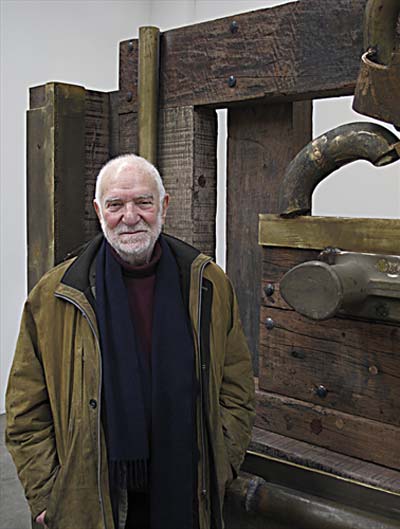
 Sculpture News at SculptSite.com
Sculpture News at SculptSite.com
Anthony Caro Plans Three-Block-Long Park Avenue Sculpture |
| Bloomberg.com Interview by Farah Nayeri Anthony Caro works in a vast warehouse stacked with dockyard leftovers. Arriving at his north London studio each day, the 86-year- old sculptor has tea and biscuits with a few assistants, then gets down to the dirty, noisy business of making art. Caro is currently showing 13 new works at London's Annely Juda Fine Art. Bulky creatures of steel and cast iron, they seem human, though Caro never meant them to give that impression. In just 18 months, he has made 43 of these upright sculptures. "I've purchased a forklift truck, which makes a lot of difference," says the artist over coffee in his studio living room, a wool scarf wrapped over his cardigan. "What used to take a morning or a day now takes 10 minutes." Caro, who sports a Hemingway-like white beard, is considered the godfather of British sculpture. At an age when peers might hang up their tools, he heads down new paths, displaying an appetite for life that his new works exude. On his to-do list is a sculpture, three blocks long, that will run down the central reservation -- the broad strip separating northbound and southbound traffic -- on New York's Park Avenue. Traveling up or down the avenue, he says, "you're going about 30 miles an hour, so you've got to make a sculpture which goes with you." The project is on hold: "The police, the traffic, all that has to be resolved before I can start." Auction Record The recent art-market craze appears to have passed him by. The most a Caro work ever fetched at auction was 1.4 million pounds (then $2.45 million), paid in February 2006 at Sotheby's London for "Sculpture Two" (1962). By contrast, Jeff Koons's most expensive sculpture -- "Balloon Flower - Magenta" (1995- 2000) -- sold at Christie's London in June 2008 for 12.9 million pounds (then $25.8 million). The works in Caro's new show range between 55,000 pounds ($85,107) and 320,000 pounds, according to the Annely Juda gallery. "It's a different world," he says of today's market. "The crazy-price things, I think, are destructive of the art because people get too conscious of money." Caro remembers a time when, after an exhibition, friends would ask how it went or whether critics liked it. "Now they say, 'Did you sell?'" he says. "It puts the wrong emphasis." Moore's BooksHe studied engineering at Cambridge, then became a part- time assistant to the late sculptor Henry Moore. He taught Caro about light, perspective and three-dimensional drawing, and lent him many art books. In 1960, Caro switched from clay to steel, prodded by the late American critic Clement Greenberg. "Clem said to me, 'If you want to change your art, change your habits,'" he recalls. "That's when I went down to the steel yards and the docks and bought some steel." Having met Greenberg and the sculptor David Smith, Caro spent time in the U.S. as of the 1960s. He taught for two years at Bennington College, and had his first one-man New York exhibition at the Andre Emmerich Gallery. His experience of the U.S., he says, was life-changing. "American artists looked at art in a completely different way: They were not literary, they were visual, and that delighted me," he says. "I caught onto America, and America caught onto my work, quite early." Acceptance back home "was much slower," he says, dating his first major U.K. show to 1969, when the Hayward Gallery staged a retrospective. Quirky Students Caro found time, between 1953 and 1981, to teach two days a week at London's St. Martin's School of Art. His pupils included the quirky duo Gilbert & George, "great fun and very nice." "They would have little tea parties, and you would have cold baked beans in an ice cream cone," Caro remembers with a laugh. "Foreign people who came along and happened to be there thought the English had strange tastes!" Today, sculpture is increasingly conceived as architecture -- as a space the visitor can enter. Caro feels close to that trend. "I think sculpture has opened up a lot, and I think I've opened it up quite a bit," he says. "Sculpture is not so much only thing, which it used to be: It's also place." He's now thinking about making a work that's more about place and less about thing. What drives him above all is an underlying optimism. He feels a world apart from a painter such as Mark Rothko, whose work got "darker and darker, and as you got to the end, you felt that suicide was the next step, and it was." "I think art is a kind of celebration, and in a way it is almost religious, in that you are trying to render thanks and joy and depth to the world that we're in," he says. "And we're lucky to be here." "Anthony Caro -- Upright Sculptures" is at Annely Juda Fine Art, London, through July 2. Information: http://www.annelyjudafineart.co.uk. To contact the writer on the story: Farah Nayeri in London at Farahn@bloomberg.net. |
 Mr. Caro's thoughts on sculpture are very telling and his thoughts on being driven by optimism are so refreshing in our hurried world. Farah Nayeri conducted a rather nice interview, making this an engaging read! |
 |
Anthony Caro Video |
More Sculpture News ....
Submit your SCULPTURE NEWS.
It's easy, just send us an e-mail
(click on Submit News in the left menu) with your pertinent information along with images, we'll take care of the rest. Sculpture makes our world a much better place in so many ways!
SculptSite.com, along with Sculptors and their creative genius all helping to bring the beauty and message of Sculpture to a hurried world.

